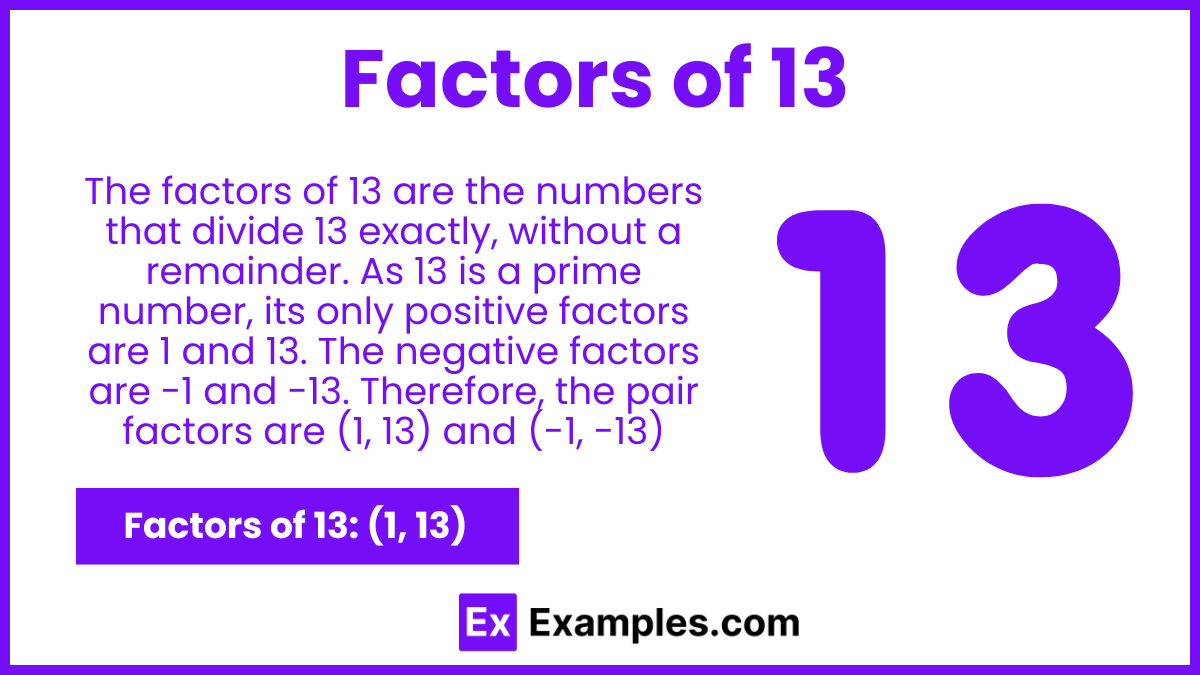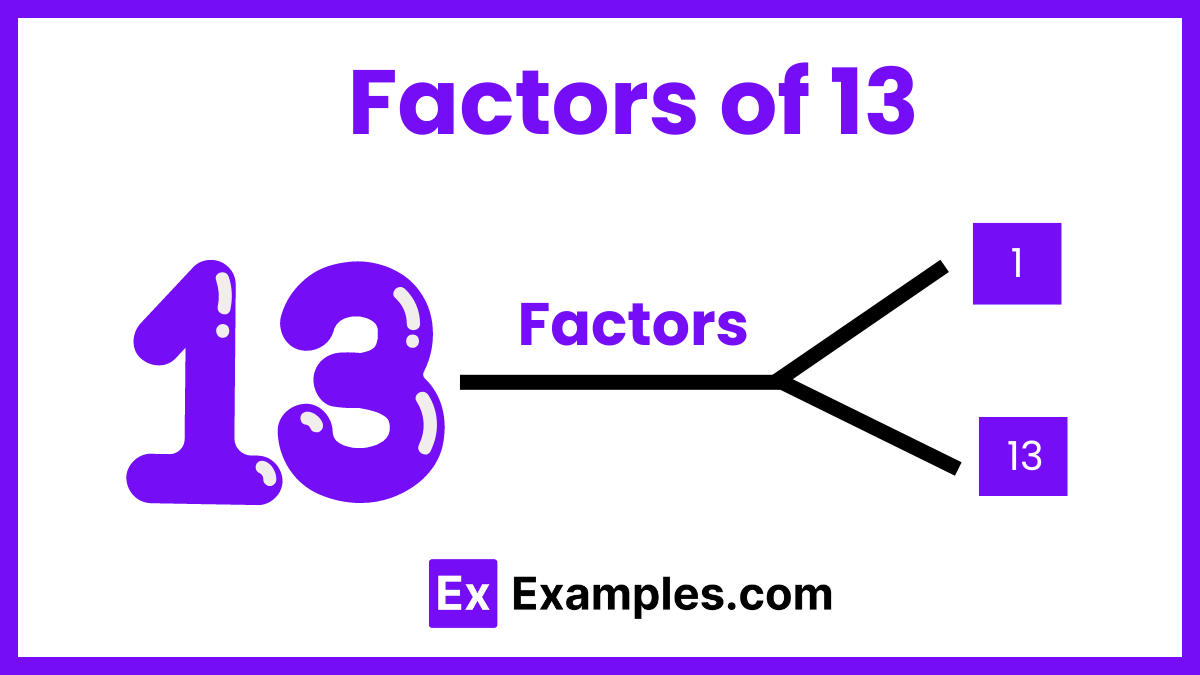What are the factors of 13?
1, 2, 13
1, 13
1, 3, 13
1, 13, 26

The factors of 13 is straightforward yet fundamental in mathematics. Since 13 is a prime number, it has only two factors: 1 and 13 itself. This means that 13 can only be divided evenly by 1 and 13, with no other divisors. Prime numbers like 13 are essential in various mathematical applications, including number theory and cryptography. Recognizing and working with prime numbers helps build a solid foundation for more advanced mathematical concepts. In this article, we will explore the properties of 13, why it is classified as a prime number, and its significance in mathematics.

The factors of 13 are quite simple to identify because 13 is a prime number. A prime number is defined as a number greater than 1 that has no divisors other than 1 and itself. Therefore, the only factors of 13 are 1 and 13. This means that 13 can only be divided evenly by 1 and by 13, with no other whole number producing a quotient without a remainder.
The factor pairs of 13 are derived from its property as a prime number.
1. In multiplication, 1 times 13 equals 13, forming the factor pair (1, 13).
2. This demonstrates that 1 and 13 are the only factors of 13, as it can only be divided evenly by these two numbers.
3. Given that 13 is a prime number, it has only one factor pair: (1, 13).
4. The unique factor pair of 13 is (1, 13), highlighting its prime nature and the simplicity of its factorization.
Calculating the prime factors of a number involves breaking down the number into the set of prime numbers that multiply together to give the original number. For the number 13, this process is straightforward because 13 is a prime number itself.
A prime number is a natural number greater than 1 that has no positive divisors other than 1 and itself. Since 13 fits this definition, it has no other divisors apart from 1 and 13.
Begin the factorization process with the smallest prime number, which is 2. Check if 13 is divisible by 2. Since 13 is an odd number, it is not divisible by 2.
Next, check divisibility by the subsequent prime numbers (3, 5, 7, 11, etc.). For each prime number, see if dividing 13 by that prime results in a whole number. Since 13 is not divisible by any of these primes without leaving a remainder, we confirm that it is not divisible by any of them.
Since 13 is not divisible by any prime number smaller than itself, we conclude that 13 is a prime number. Therefore, the prime factor of 13 is 13 itself.
The prime factor of 13 is simply 13. No further factorization is possible as it is already in its prime form.
Determine if 1 is a factor of 13.
Any number is divisible by 1.
13÷1=13.
Therefore, 1 is a factor of 13.
Determine if 2 is a factor of 13.
Check if 13 is divisible by 2.
13÷2=6.5.
Since 6.5 is not an integer, 2 is not a factor of 13.
Determine if 13 is a factor of 13.
Check if 13 is divisible by 13.
13÷13=113÷13=1.
Since 1 is an integer, 13 is a factor of 13.
Determine if 3 is a factor of 13.
Check if 13 is divisible by 3.
13÷3=4.333.
Since 4.333 is not an integer, 3 is not a factor of 13.
List all factors of 13.
To find all factors, check divisibility by all integers from 1 to 13.
Only 1 and 13 divide 13 without leaving a remainder.
Therefore, the factors of 13 are 1 and 13.
Understanding the factors of a number is fundamental in arithmetic and algebra. Factors are numbers that divide a given number exactly without leaving a remainder. When it comes to prime numbers like 13, identifying factors is straightforward yet crucial for various mathematical applications. Here are some key tips to help you grasp the factors of 13:
13 is a prime number, which means it can only be divided by 1 and itself without leaving a remainder. Prime numbers always have exactly two factors.
No, 13 cannot be divided evenly by any number other than 1 and 13. Any other division will result in a fraction or a remainder, confirming that 13 is a prime number.
Common multiples of 13 are numbers that can be divided evenly by 13. Examples include 26, 39, 52, and so on. These multiples are found by multiplying 13 by integers (13 x 2, 13 x 3, etc.).
To find the GCD of 13 and another number, list the factors of both numbers. Since 13 is a prime number, its only factors are 1 and 13. The GCD will be 1 unless the other number is also a multiple of 13.
To simplify fractions involving 13, divide the numerator and the denominator by their greatest common divisor. If the numerator or the denominator is 13, and the other number is not a multiple of 13, the fraction is already in its simplest form.
The positive pair factors of 13 are (1, 13) and (13, 1). The negative pair factors of 13 are (-1, -13) and (-13, -1). These pairs, when multiplied together, result in 13, illustrating that both positive and negative numbers can be factors.
The prime factorization of 13 is simply 13 itself. Since 13 is a prime number, it cannot be divided by any other number except 1 and 13. Therefore, its prime factorization is 13, indicating that it has no other prime factors.
The sum of all the factors of 13 is 14. The factors of 13 are 1 and 13. When you add these factors together (1 + 13), the total is 14. This sum is useful in various mathematical calculations and number theory.
Text prompt
Add Tone
10 Examples of Public speaking
20 Examples of Gas lighting
What are the factors of 13?
1, 2, 13
1, 13
1, 3, 13
1, 13, 26
Which of the following numbers is a factor of 13?
2
3
4
13
How many factors does the number 13 have?
1
2
3
4
The number 13 is a factor of which of the following numbers?
26
27
28
29
If a number is divisible by 13, which of these must be true?
The number ends in 3
The number is greater than 26
The number is a multiple of 13
The number is a multiple of 12
Which of these numbers is not a factor of 13?
1
2
13
15
What is the smallest multiple of 13?
13
26
31
36
Which number, when divided by 13, leaves a remainder of 0?
25
39
45
50
What is the result of dividing 65 by 13?
4
5
6
7
Which of these numbers is a multiple of 13?
30
40
52
60
Before you leave, take our quick quiz to enhance your learning!

